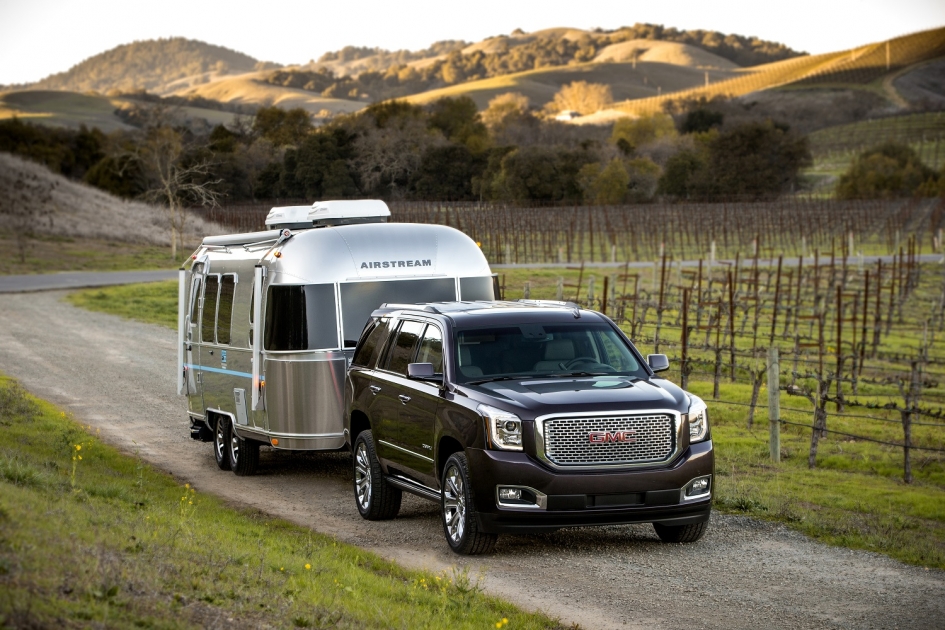
GMC’s 10 Tips for Trouble-Free Trailering
Before setting off with a trailer in tow for your weekend desert or Mountain escape, cross country road trip or weekend boating adventure, GMC offers a few tips and reminders to help ensure your experience is safe, fun and easy.
1. Under pressure. Proper tire inflation is essential when trailering for optimal handling, driver control and fuel economy – and that doesn’t include only the vehicle pulling the trailer. Check the trailer’s tires, too and don’t exceed the manufacturer’s speed rating for them. It ranks with under-inflation as a major cause of trailer tire failure. While you’re walking around the vehicle for inspection, it’s a good time to check the lights, signals and hitch connections.
2. Spare me. Your vehicle has a spare tire, but does your trailer? A flat trailer tire and no spare in a remote area can quickly ruin your day. Make sure you’ve got a spare and that it’s properly inflated.
3. A view un-askew. The regular position of your vehicle’s outside mirrors may not be suitable when you add a trailer. Adjust them so that the rear of the trailer can be seen at a glance, for a clearer view of what’s behind the trailer or beside it when changing lanes or turning a corner. You may also want to consider adding temporary trailering mirrors for a wider view. For trucks already equipped with trailer tow mirrors, pull them out to the extended position and adjust the lower mirror to view the trailer tires, to help judge clearance to curbs or obstacles.
4. Sharing the load. When loading a trailer, don’t put the majority of the weight on the rear of it. That can cause sway and instability. The weight should be distributed so that at least 10 percent is on the hitch. Check periodically on your trip to ensure the cargo hasn’t shifted. Check tie-down straps, too, at the same time to make sure they’re still tight.
5. Parking perfection. Plan your moves ahead and try to find parking lots, gas station pumps or outdoor spaces where you can pull straight through, without the need for backing or sharp turns.
6. Reversing course. Backing up with a trailer can be difficult. Start by placing your hand at the bottom of the steering wheel and looking over your shoulder. Move your hand to the right to make the trailer go right and left to make it go left. If the trailer starts to jackknife, simply pull forward to straighten it out and start over.
7. Cutting corners. For sharp, 90-degree corners such as intersections, pull the vehicle a little farther up into the road before turning and try to cut a wider arc when doing so. That will help prevent the trailer from hopping over the curb or brushing up against something on the side of the road.
8. Braking good. Certain types of trailers require trailer brakes – and even with them, your loaded vehicle and trailer will require more distance for stopping, so keep that in mind as you exit the freeway. You’ll need to leave extra space between you and the vehicle ahead, too.
9. Sway away: If the trailer begins to sway excessively or “whipsaw” on the highway, simply take your foot off the gas pedal to reduce momentum. Do not hit the brakes or speed up.
10. Downhill run. For greater control when driving on steeper downhill grades, take your foot off the gas and slow down just before the grade begins. If your vehicle is equipped with tow/haul mode or a diesel engine brake, be sure it is activated, which enhances engine braking without dragging or overheating the brakes.
VEHICLE CALLOUTS:
GMC Sierra 1500 Regular Cab
Max. trailering: 2721 Kgs (4.3L V-6)
GMC Sierra 1500 Denali
Max. trailering: 5307 Kgs (6.2L V-8 with Max Towing Pkg.)
GMC Sierra HD 3500
Max. trailering: 6577 Kgs. (6.0L VORTEC with conventional hitch)
6622 Kgs. (6.0L VORTEC with fifth-wheel hitch)



























